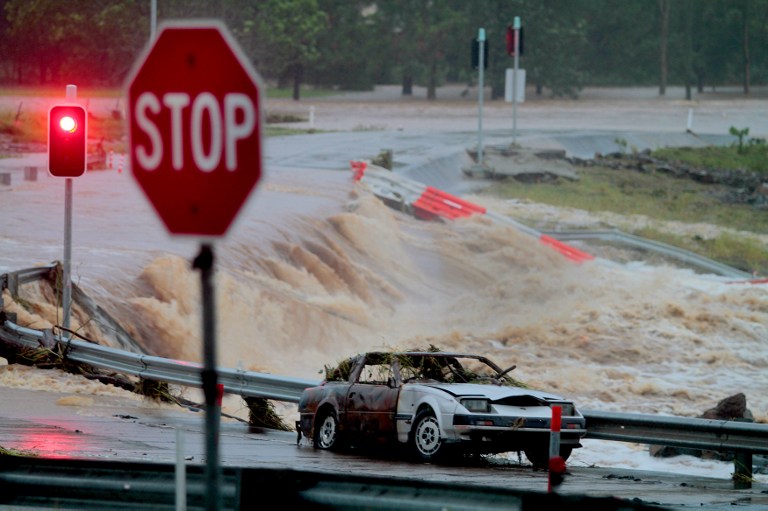SUMMARY
This is AI generated summarization, which may have errors. For context, always refer to the full article.

BRISBANE, Australia – Australia ramped up its military response to deadly floodwaters rising in the country’s sodden northeast Tuesday, January 29, which have killed four people and displaced or isolated tens of thousands.
Storms triggered by ex-tropical cyclone Oswald have claimed four lives — the most recent a three-year-old boy killed by a falling tree — as heavy rains have brought flooding to the states of Queensland and New South Wales.
The sugar farming town of Bundaberg waited anxiously for the swollen Burnett River to peak at a record 9.6 meters (32 feet), with officials saying some 2,000 homes and 300 businesses were already flooded.
Queensland Police Minister Jack Dempsey said about 7,500 residents had been displaced by the floodwaters, with 1,000 people plucked from the roofs of their homes in daring evening rescues after the river broke its banks late Monday.
Premier Campbell Newman toured Bundaberg from the air and said it was an “extraordinary” scene, paying tribute to military rescue teams who toiled until midnight using night vision equipment.
“I think the bravery of the air crew and the helicopters, both civilian and defense force who worked all yesterday afternoon and into the night evacuating people in quite difficult circumstances is what saved the day,” said Newman.
“We did have a situation of fast-rising floodwaters and people being very rapidly isolated on ever-diminishing islands of ground.”
Prime Minister Julia Gillard said four military helicopters, 100 troops and two Hercules transport aircraft had been deployed to the emergency, with the evacuation of patients from Bundaberg’s hospital to Brisbane a priority.
“We’ll also be making available one of the huge aircraft, the C17, to transport equipment that is needed to Bundaberg for the Queensland Fire and Rescue Service and for the Queensland Ambulance Service,” Gillard said.
There was some flooding in the state capital Brisbane, home to about two million people, which was brought to a standstill for several days by a huge inundation in 2011 that swamped 30,000 homes and killed more than 30 people.
Brisbane mayor Graham Quirk said some city businesses had been swamped for a second time but there were no reports of homes flooding inside, with the Brisbane River peaking lower than had been forecast.
Insurers had already received some 6,100 claims from Queensland worth Aus$72 million (US$75 million), according to the Insurance Council of Australia.
Oswald brought wild storms to neighboring New South Wales overnight, with floodwaters isolating 23,000 people and prompting authorities to order 2,100 people to evacuate from the town of Grafton. Another 7,000 were put on notice that they may have to follow suit.
“We are faced today with an unprecedented rise in the Clarence River in Grafton and no doubt downstream,” mayor Richie Williamson told reporters at a briefing in Grafton.
“On Thursday and Friday we were nearly in drought conditions. Here we are on Tuesday morning talking about the biggest flood on the history books.”
Wild weather ripped up trees up and brought dangerous surf conditions in Sydney, with waves of up to 10 meters reported. – Rappler.com
Add a comment
How does this make you feel?
There are no comments yet. Add your comment to start the conversation.